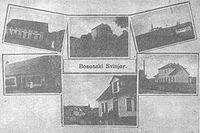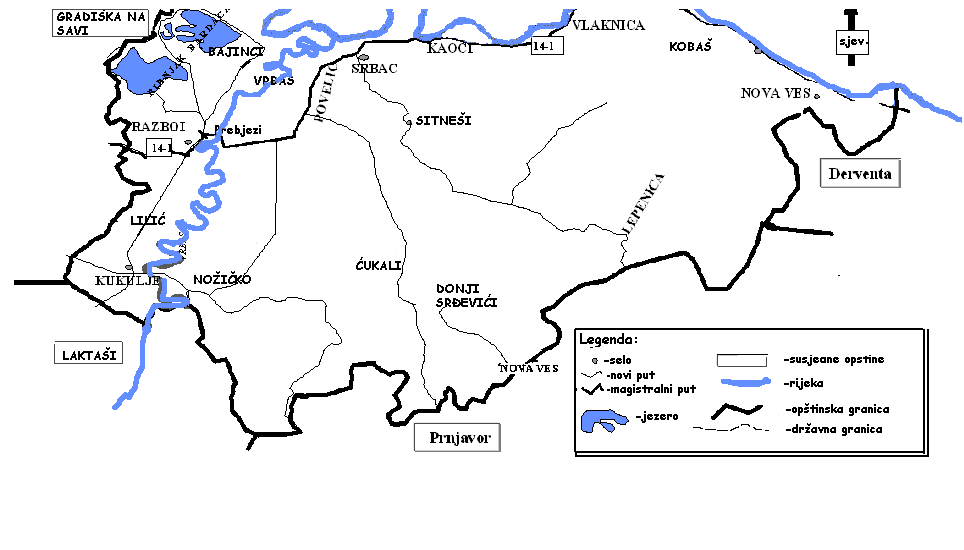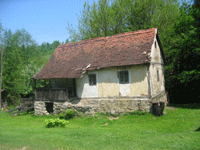
Srbac
Encyclopedia
Srbac is a town and municipality
on the northern border of Bosnia and Herzegovina
with Croatia
. Srbac is located in the Republika Srpska
entity at the entry of river Vrbas into river Sava.
of Yugoslavia
on November 2, 1933.
Srbac is about 400 km away from Serbian capital Belgrade and 250 km away from Croatian capital Zagreb. It is situated on the mouth of the river Vrbas which then flows into Sava River which was the longest river in former Yugoslavia.
 Srbac covers some 453 km² (174.9 mi²) of land in northern Bosnia
Srbac covers some 453 km² (174.9 mi²) of land in northern Bosnia
situated at the entry of the river Vrbas into river Sava. Municipality consists of 39 villages. The city is located at 45.06° N 17.31° E.
The source of the river Vrbas
is about 140 km (87 mi) to the south, and the tributary rivers of Suturlija, Crkvena, and Vrbanja flow into the Vrbas at the city of Banja Luka
.
The area around Srbac is mountainous woodland to the south-east (40% of the total area) and farmland to the south-west (60% of total area). The city itself is built in the Pannonia
valley, which is located on the transition between low mountain areas and flat farmlands. The mountain ranges to the south-east are called Motajica and the highest peak is called Gradina at 652m above sea level. The lowest point is 89m in the Vlaknica (small village) farmlands along the Sava river. The northern border of the municipality with the Republic of Croatia
is 42 km long.
, with harsh winters and warm summers. The warmest month of the year is July, with an average temperature of 25°C (77°F). The coldest month of the year is January, when temperatures average -5°C (23 °F).
Annual precipitation for Srbac is about 875 mm. Due to the city's high latitude; it snows in Srbac almost every year as well. Strong winds come from the north and northeast bringing in lots of snow.

 A town existed in this region even during the Iron Age, a town named Cagan city (Cagan Grad). To this day a small area near Srbac is called Cagani. Before the collapse of the western Roman empire a town is mentioned in this area also. After that in this region a town named Svinjar is mentioned. However a town or city in this location could never grow and develop. The sad fact is that through the past centuries this region was trampled over by various invading forces, burning and destroying everything.
A town existed in this region even during the Iron Age, a town named Cagan city (Cagan Grad). To this day a small area near Srbac is called Cagani. Before the collapse of the western Roman empire a town is mentioned in this area also. After that in this region a town named Svinjar is mentioned. However a town or city in this location could never grow and develop. The sad fact is that through the past centuries this region was trampled over by various invading forces, burning and destroying everything.
In the written documents from 1596 at the time of the great war, Ahmet Hafiz-pasha in the same year transported his huge army across river Sava from Turkish Slavonija at Svinjar into Bosnia. Literal translation of Svinjar meaning swine stable.German
map dating back to 1621 calls it Svinjar as well. During this time Ottoman Turks
ruled the region and Srbac was part of the Bosnian pashaluk. During the uprising against the Ottoman Empire
in Bosnia and Herzegovina
in the years of 1875 to 1878 Svinjar is mentioned as an important place in the history of the uprising. One of the battles against the Turks
took place here on the 21st of November 1875 at a place called Srbac where Motajički haiduks destroyed a Turkish military camp and burned everything.
In 1888 a primary school is opened in Svinjar. Towards the end of 1929 a medical centre was also opened in Svinjar. In the late 19th century Svinjar was under the Austrian-Hungary rule. Between the years of 1899 to 1921 around 7000 Poles and around 5000 Ukrainians migrated and settled in the area. On the 2nd of November 1933 the minister of internal affairs of the Kingdom of Yugoslavia
changed the towns name from Bosanski Svinjar to Srbac.
During World War II
these parts were frequently invaded by all the waring sides. During the 70s Srbac saw rapid growth with the opening of a new textile factory and a packaging material factory. However all the economic growth stopped during the latest Bosnian war. Srbac was only bombarded 3 times during the war by the Croatian forces in the summer of 1992. No one was killed in these 3 incidents and Srbac suffered only minor structural damage.

Municipality
A municipality is essentially an urban administrative division having corporate status and usually powers of self-government. It can also be used to mean the governing body of a municipality. A municipality is a general-purpose administrative subdivision, as opposed to a special-purpose district...
on the northern border of Bosnia and Herzegovina
Bosnia and Herzegovina
Bosnia and Herzegovina , sometimes called Bosnia-Herzegovina or simply Bosnia, is a country in Southern Europe, on the Balkan Peninsula. Bordered by Croatia to the north, west and south, Serbia to the east, and Montenegro to the southeast, Bosnia and Herzegovina is almost landlocked, except for the...
with Croatia
Croatia
Croatia , officially the Republic of Croatia , is a unitary democratic parliamentary republic in Europe at the crossroads of the Mitteleuropa, the Balkans, and the Mediterranean. Its capital and largest city is Zagreb. The country is divided into 20 counties and the city of Zagreb. Croatia covers ...
. Srbac is located in the Republika Srpska
Republika Srpska
Republika Srpska is one of two main political entities of Bosnia and Herzegovina, the other being the Federation of Bosnia and Herzegovina...
entity at the entry of river Vrbas into river Sava.
Name
Srbac got its name from the governmentGovernment
Government refers to the legislators, administrators, and arbitrators in the administrative bureaucracy who control a state at a given time, and to the system of government by which they are organized...
of Yugoslavia
Yugoslavia
Yugoslavia refers to three political entities that existed successively on the western part of the Balkans during most of the 20th century....
on November 2, 1933.
Srbac is about 400 km away from Serbian capital Belgrade and 250 km away from Croatian capital Zagreb. It is situated on the mouth of the river Vrbas which then flows into Sava River which was the longest river in former Yugoslavia.
Geography

Bosnia and Herzegovina
Bosnia and Herzegovina , sometimes called Bosnia-Herzegovina or simply Bosnia, is a country in Southern Europe, on the Balkan Peninsula. Bordered by Croatia to the north, west and south, Serbia to the east, and Montenegro to the southeast, Bosnia and Herzegovina is almost landlocked, except for the...
situated at the entry of the river Vrbas into river Sava. Municipality consists of 39 villages. The city is located at 45.06° N 17.31° E.
The source of the river Vrbas
Vrbas
Vrbas may refer to:* Vrbas , river in Bosnia and Herzegovina* Vrbas , town and municipality in Vojvodina, Serbia* Vrbas , village in Bosnia and Herzegovina...
is about 140 km (87 mi) to the south, and the tributary rivers of Suturlija, Crkvena, and Vrbanja flow into the Vrbas at the city of Banja Luka
Banja Luka
-History:The name "Banja Luka" was first mentioned in a document dated February 6, 1494, but Banja Luka's history dates back to ancient times. There is a substantial evidence of the Roman presence in the region during the first few centuries A.D., including an old fort "Kastel" in the centre of...
.
The area around Srbac is mountainous woodland to the south-east (40% of the total area) and farmland to the south-west (60% of total area). The city itself is built in the Pannonia
Pannonia
Pannonia was an ancient province of the Roman Empire bounded north and east by the Danube, coterminous westward with Noricum and upper Italy, and southward with Dalmatia and upper Moesia....
valley, which is located on the transition between low mountain areas and flat farmlands. The mountain ranges to the south-east are called Motajica and the highest peak is called Gradina at 652m above sea level. The lowest point is 89m in the Vlaknica (small village) farmlands along the Sava river. The northern border of the municipality with the Republic of Croatia
Croatia
Croatia , officially the Republic of Croatia , is a unitary democratic parliamentary republic in Europe at the crossroads of the Mitteleuropa, the Balkans, and the Mediterranean. Its capital and largest city is Zagreb. The country is divided into 20 counties and the city of Zagreb. Croatia covers ...
is 42 km long.
Climate
Srbac has a continental climateContinental climate
Continental climate is a climate characterized by important annual variation in temperature due to the lack of significant bodies of water nearby...
, with harsh winters and warm summers. The warmest month of the year is July, with an average temperature of 25°C (77°F). The coldest month of the year is January, when temperatures average -5°C (23 °F).
Annual precipitation for Srbac is about 875 mm. Due to the city's high latitude; it snows in Srbac almost every year as well. Strong winds come from the north and northeast bringing in lots of snow.
History


In the written documents from 1596 at the time of the great war, Ahmet Hafiz-pasha in the same year transported his huge army across river Sava from Turkish Slavonija at Svinjar into Bosnia. Literal translation of Svinjar meaning swine stable.German
Germany
Germany , officially the Federal Republic of Germany , is a federal parliamentary republic in Europe. The country consists of 16 states while the capital and largest city is Berlin. Germany covers an area of 357,021 km2 and has a largely temperate seasonal climate...
map dating back to 1621 calls it Svinjar as well. During this time Ottoman Turks
Ottoman Turks
The Ottoman Turks were the Turkish-speaking population of the Ottoman Empire who formed the base of the state's military and ruling classes. Reliable information about the early history of Ottoman Turks is scarce, but they take their Turkish name, Osmanlı , from the house of Osman I The Ottoman...
ruled the region and Srbac was part of the Bosnian pashaluk. During the uprising against the Ottoman Empire
Ottoman Empire
The Ottoman EmpireIt was usually referred to as the "Ottoman Empire", the "Turkish Empire", the "Ottoman Caliphate" or more commonly "Turkey" by its contemporaries...
in Bosnia and Herzegovina
Bosnia and Herzegovina
Bosnia and Herzegovina , sometimes called Bosnia-Herzegovina or simply Bosnia, is a country in Southern Europe, on the Balkan Peninsula. Bordered by Croatia to the north, west and south, Serbia to the east, and Montenegro to the southeast, Bosnia and Herzegovina is almost landlocked, except for the...
in the years of 1875 to 1878 Svinjar is mentioned as an important place in the history of the uprising. One of the battles against the Turks
Ottoman Empire
The Ottoman EmpireIt was usually referred to as the "Ottoman Empire", the "Turkish Empire", the "Ottoman Caliphate" or more commonly "Turkey" by its contemporaries...
took place here on the 21st of November 1875 at a place called Srbac where Motajički haiduks destroyed a Turkish military camp and burned everything.
In 1888 a primary school is opened in Svinjar. Towards the end of 1929 a medical centre was also opened in Svinjar. In the late 19th century Svinjar was under the Austrian-Hungary rule. Between the years of 1899 to 1921 around 7000 Poles and around 5000 Ukrainians migrated and settled in the area. On the 2nd of November 1933 the minister of internal affairs of the Kingdom of Yugoslavia
Kingdom of Yugoslavia
The Kingdom of Yugoslavia was a state stretching from the Western Balkans to Central Europe which existed during the often-tumultuous interwar era of 1918–1941...
changed the towns name from Bosanski Svinjar to Srbac.
During World War II
World War II
World War II, or the Second World War , was a global conflict lasting from 1939 to 1945, involving most of the world's nations—including all of the great powers—eventually forming two opposing military alliances: the Allies and the Axis...
these parts were frequently invaded by all the waring sides. During the 70s Srbac saw rapid growth with the opening of a new textile factory and a packaging material factory. However all the economic growth stopped during the latest Bosnian war. Srbac was only bombarded 3 times during the war by the Croatian forces in the summer of 1992. No one was killed in these 3 incidents and Srbac suffered only minor structural damage.
1971
21,840 total.- Serbs - 19.382 (88,75%)
- Muslims - 940 (4,30%)
- Croats - 140 (0,64%)
- Yugoslavs - 811 (3,71%)
- Others - 567 (2,60%)
1991
In 1991, the population of the Srbac municipality numbered 21,660 inhabitants, including:- 19,291 SerbsSerbsThe Serbs are a South Slavic ethnic group of the Balkans and southern Central Europe. Serbs are located mainly in Serbia, Montenegro and Bosnia and Herzegovina, and form a sizable minority in Croatia, the Republic of Macedonia and Slovenia. Likewise, Serbs are an officially recognized minority in...
(See: Serbs of Bosnia and HerzegovinaSerbs of Bosnia and HerzegovinaThe Serbs of Bosnia and Herzegovina are people of Serb ethnicity inhabiting the Balkan regions of Bosnia and Herzegovina, or, since the establishment of Bosnia and Herzegovina as a state in the 1990s, the Serbs who have its citizenship. The Serbs are one of the three constitutive nations of this...
) (89.06%) - 940 Muslims by nationalityMuslims by nationalityMuslims by nationality was a term used in Socialist Federal Republic of Yugoslavia as an official designation of nationality of Slavic Muslims. They were one of the constitutive groups of Bosnia and Herzegovina...
(4.34%) - 754 YugoslavsYugoslavsYugoslavs is a national designation used by a minority of South Slavs across the countries of the former Yugoslavia and in the diaspora...
(3.48%) - 145 CroatsCroatsCroats are a South Slavic ethnic group mostly living in Croatia, Bosnia and Herzegovina and nearby countries. There are around 4 million Croats living inside Croatia and up to 4.5 million throughout the rest of the world. Responding to political, social and economic pressure, many Croats have...
(See: Croats of Bosnia and HerzegovinaCroats of Bosnia and HerzegovinaCroats of Bosnia and Herzegovina form one of the three constitutive nations in Bosnia and Herzegovina.There is no precise data regarding Bosnia and Herzegovina's population since the last war. Ethnic cleansing within Bosnia and Herzegovina in the 1990s saw the vast majority of Croats move and take...
) (0.70%) - 530 others (2.4%)
See also

- Municipalities of Republika SrpskaMunicipalities of Republika SrpskaUnder the "Law on Territorial Organization and Local Self-Government" adopted in 1994, Republika Srpska was divided into 80 municipalities. After the conclusion of the Dayton Peace Agreement, the law was amended in 1996 to reflect the changes to the entity's borders and now provides for the...

